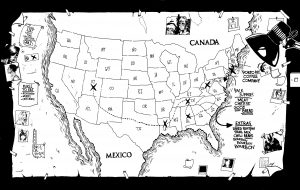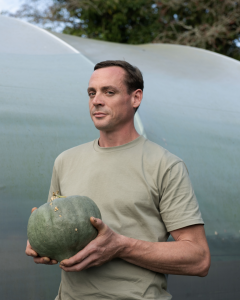The prolific writer recalls the extraordinary circumstances in the early 70s surrounding one of her most iconic personal portrait shoots

‘Almost pathetically serious’ – so Vogue wrote of the 32-year-old novelist whose photograph appeared in the August 15, 1970 issue of the magazine. The writer went on to note that the novelist, whose fourth novel them, had received the National Book Award for 1970, was ‘tentative, hush-voiced, with the fixed brown eyes of a sleepwalker’ and that ‘daydreaming’ had given to her writing a ‘peculiar floating quality’ somewhat at odds with the violence of her subject. An excerpt from the novelist’s National Book Award acceptance speech was quoted: “What an artist has to resist and turn to his advantage is violence.” The photo-replica of the novelist’s face of 1970, strangely without expression, masklike and dreamy and ‘serene’, ironically gave no indication of the maelstrom of emotions she was feeling at the time of the photo shoot: excitement, wonderment, stress, a kind of chronic ontological anxiety.
Photographed for Vogue! The most elegant, as it was the most daunting and mysterious, of the several glossy magazines my grandmother Blanche Morgenstern, herself a somewhat mysterious woman, brought to our house in Millersport, New York, when I was growing up in the 1950s. Other magazines were the more practical-minded Redbook, McCall’s, Cosmopolitan (in an earlier, earnest and even ‘literary’ incarnation,) Ladies’ Home Journal and Good Housekeeping; the career-girl Mademoiselle (where in 1959 my first published story, ‘In the Old World’, appeared); and The New Yorker, most prized in our household for its cartoons, and inhabited by fey, epicene individuals we assumed were New York City sophisticates. My grandmother Blanche was an accomplished seamstress, sewing for me, and sometimes for my mother, not only skirts, blouses, jumpers but also suits and coats; my grandmother chose her designs from Butterick, Simplicity, McCall’s, but also – at times – Vogue, which were the most difficult (and chic) patterns; it was for the sake of the fashion features in Vogue that my grandmother bought the expensive magazine, thick as a phone book with astonishing photographs. Of all the magazines that came into the house it was Vogue that evoked the most fascination to a girl living on a small not-very-prosperous farm in upstate New York, as it was Vogue that aroused in my father the most sardonic of remarks relating to women’s fashions. (Many of Daddy’s remarks, expressing bemused indignation, began with a scowl and a muttered “Jay-sus!”) Both Daddy and I would have been stunned speechless if we could have known that, one day, the name ‘Oates’ would appear in Vogue, as both byline and subject.
For here was a trove of the mystical, magically empowered feminine, distinct from the (merely) utilitarian female (on a farm, females have their specific uses, none of which is romantic in the slightest): Vogue was, among other things, a shrine honouring sheer nonutilitarian beauty, most of which happened to be, not female, but feminine. It would be decades before I encountered Sigmund Freud’s remark in his late, melancholy Civilization and its Discontents: ‘Beauty has no obvious use; nor is there any clear cultural necessity for it. Yet civilization could not do without it.’
Already in early adolescence I had become an astute observer of worlds so foreign to my own, I might have been contemplating the photographs of women and men from another species, captured, for Vogue, by the lenses of such legendary photographers as Richard Avedon and Irving Penn. No more than I might have fantasised looking like any of these socialites and models wearing extraordinary clothes, jewels and footwear could I have imagined seeing myself one day in Vogue.
On March 4, 1970 I had received the National Book Award for my novel them at a gala celebration in New York City; this portrait was taken in the late morning of March 6, in a studio in a townhouse on West 11th Street. Amid a flurry of interviews and photography sessions during my brief, vertiginous visit to New York City for the National Book Award event, this image is the only one that is dramatically imprinted in my memory. What is evoked in the portrait for me is a perverse sort of nostalgia: the recollection of that era of peril, beginning with the tragic and dispiriting assassination of John F. Kennedy in 1963, and continuing through a dazed, near-anarchic decade of assassinations and ‘race riots’ in American cities (as infamously in Detroit in July 1967 when my husband Ray Smith and I were living in that beleaguered city) through the end of the bloody, protracted and exhausting Vietnam War in 1973. It is an era difficult to evoke to those who didn’t live through it: when paranoia flourished, and with justification; drug use became as commonplace as cigarettes; and isolated acts of terrorism, bombs on college campuses, for instance, or detonated at the Pentagon, were purely ‘American-revolutionary-radical’ and not foreign. For on the morning of the photo shoot on West 11th St., after a night of fitful sleep in a spacious, elegantly shabby Central Park West apartment listening to the night-time noises of the great city (if sirens were neon-red traceries in the sky, how like a cat’s cradle the sky above New York City would look!), as I sat stiff and self-conscious trying not to blink in the glaring lights, trying, as the photographer gently urged me, to “relax – smile,” there came suddenly, from somewhere alarmingly close by, a deafening explosion. Windows in the photographer’s studio rattled; the floors, walls, ceiling of the studio shook; for a terrible moment, it seemed that the very brownstone would shatter and collapse around us.
Abruptly, the photo shoot for Vogue ceased.
Perhaps it was at this instant that the image was ‘captured’ on film: the instant when the private and inward is waylaid, appropriated and redefined by an act of violence.
In such an instant you feel sick, animal fear. You become totally physical, visceral. Panic floods your veins, your heartbeat runs wild. Your confused thoughts are of the most primitive sort – Am I injured? Am I alive? Am I in danger? Am I – all right?
For it is not uncommon, that individuals who are terribly, even fatally injured will imagine, initially, that they are all right. If they can breathe, or move an arm – desperately the brain signals: Yes. I am alive – I am all right.
I was reminded of the more protracted panic we’d felt, trapped in our house on Sherbourne Road, Detroit several years before. From sometime in the early morning of July 23, 1967 – (when Detroit police raided an unlicensed ‘drinking club’ on 12th Street in an African-American neighbourhood) – for 48 hours or more we’d remained in our house hoping it would not be set on fire, or that police or snipers wouldn’t shoot into our windows; less than three blocks from our house, on Livernois Avenue, store windows were smashed, and stores were looted; there were arson fires, looting, gunfire, street violence, near-continuous sirens. It was as if – literally – the world had erupted into madness. At such times of peril you think, pleadingly – This can’t be happening to us! And if you are very lucky, it isn’t.
The photographer, the photographer’s assistants, and I staggered out of the brownstone on West 11th Street, and onto the sidewalk, where the air was befouled – smoky and gritty. We were dazed, panicked. What had happened? Were we in danger – would there be another explosion? With stunning abruptness the intimate moment of ‘art’ had ended to be replaced by this brute and utterly perplexing reality, of which we could make little sense. Around us were frightened pedestrians, stalled traffic, a cacophony of sirens and horns. No one had an idea what the explosion had been: a boiler? Gas line? Bomb?
A block away, in the direction of Fifth Avenue, it seemed that flames shot upward from what appeared to be a brownstone townhouse. It would turn out to have been an elegant 19th-century house with a Greek Revival façade, the boyhood home of the poet James Merrill.
Later, it would be revealed that the explosion had been inadvertently caused by an amateur bomb-maker who’d triggered a timer on a homemade ‘antipersonnel’ bomb being assembled in the basement of a house at 18 West 11th St. by members of the radical group the Weathermen; their murderous intention had been to set off the bomb at a dance at the Fort Dix, New Jersey army base. The bomb detonated that morning, killed three individuals, two men and a woman named Diana Oughton, former debutante and Bryn Mawr graduate, whose body was grotesquely dismembered in the blast and who would be identified only by fingerprints; fleeing from the burning house, on foot, were two female Weathermen, one of them Kathy Boudin, later to acquire notoriety of her own. That season of peril. The sour, sick dregs of 1960s counter-culture idealism. In such rocky soil the seeds of nostalgia yet grow.
My husband and I left New York City the next morning, to drive back to Windsor, Ontario, Canada where we now lived. It had come to seem an ironic commemoration: my novel them, set in Detroit, Michigan in the era of the riot, and yet something of a valentine for the Detroit of those years, had been honoured only after I’d departed Detroit forever, to move across the Detroit River to a more hospitable, as it was a Canadian, city, where the buildings and grounds of the University of Windsor partly fronted the river. Living in Ontario during the ongoing, spiritually exhausting crisis of the Vietnam War, in a foreign country with the advantage of hardly seeming foreign, I would gaze out the windows of my study at the fast-flowing, choppy, often lead-coloured river at the foot of our lawn and I would feel a pang of loss, that I had been expelled from the United States seemingly, out of despair and frustration with American politics of the time, and out of a genuine wish to work with those young Americans known contemptuously as ‘draftdodgers’ – individuals who seemed courageous to me, in their refusal to fight what appeared even then to be a futile and unjust war – as well as with excellent Canadian students, for whom high school was four years in contrast to the three years of American high school, and who were consequently much better prepared for university than American students. Ten years in exile, in Ontario – a fruitful and altogether wonderful decade, that ended too soon.
And often I would remember, seeing the Vogue photo which my practical-minded publisher would use on my book jacket covers for years, the circumstances of that dramatic photo shoot; how curious and fleeting is the intimacy between photographer and ‘subject’, how abruptly it can end; and the image that remains can be both timeless and timebound, a memory of nightmare crystallised in art.
Just now, on a balmy late morning in May 2014, I have walked past the brick townhouse at 18 West 11th St., an entirely new building of course, refashioned, more ‘modern’ than the old, amid a block of handsome, highly respectful, and very expensive West Village properties. From somewhere close by, on Fifth Avenue, a siren is wailing – but soon fades.




